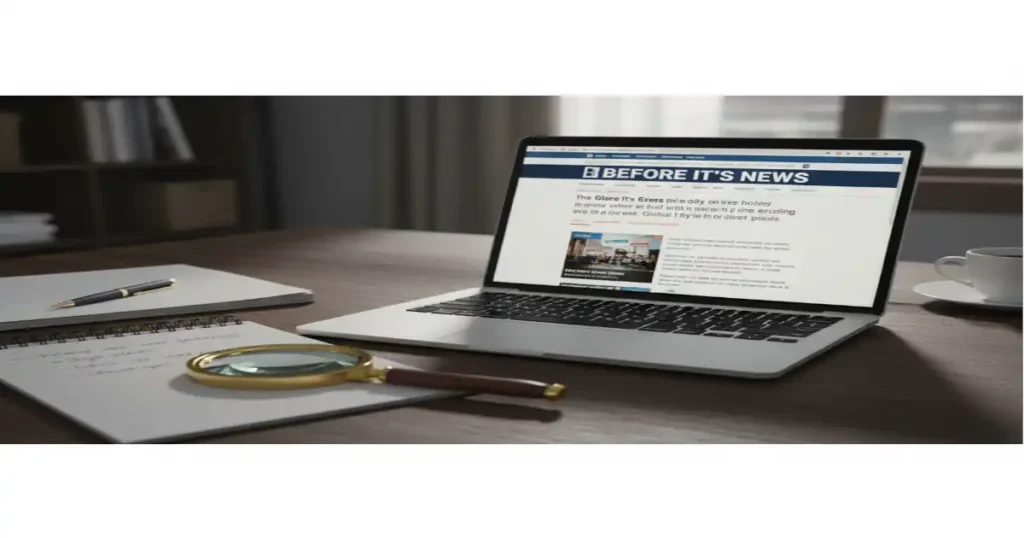Wondering if news beforeitsnews shares real scoops or wild tales? This simple 2025 chat breaks down its setup, flags, and better picks to keep your info safe and smart.
Hey there, friend! Have you ever scrolled online and stumbled on a story that sounds too wild to be true? That’s how many folks feel about Before It’s News. It’s this spot where people share tips before big news hits. But is it a gem or a trap? Let’s chat about it like we’re grabbing coffee. I’ll keep things easy and fun, sharing what I’ve learned so you can decide for yourself.
Key Takeaways
- Before It’s News lets anyone post stories, but lots mix real bits with crazy ideas always check facts first!
- It’s got a fun side for new views, but pros say it’s not trusty because of wild theories and no checks.
- Try spots like AllSides instead to see all sides without the mess.
- Look for proof links to spot real news saves you time and headaches.
- In 2025, blend user shares with pro news for a solid info mix.
What Is News Beforeitsnews?
Picture a big online board where everyday folks pin up news bits they think are hot. That’s Before It’s News in a nutshell. It started as a place for “people-powered” shares, covering stuff like space mysteries, world events, and home remedies. The cool part? Stories pop up fast, sometimes days before TV news grabs them.
But wait, there’s a flip side. Since no one checks the posts, you get a mix of okay info and total nonsense. It’s like a yard sale some treasures, but lots of junk too. Over a million people peek at it each month, based on web traffic stats. That shows it’s popular, but popularity doesn’t mean it’s right.
How It Works
Anyone can sign up and drop a story with pics or clips. The hot ones rise up based on likes and views. It’s simple, like posting on a group chat. This setup draws in citizen reporters who feel ignored by big media. Yet, without rules, wild claims sneak in easy. Think of it as a free-for-all chat room for news fans.
A Quick History Lesson
Back in 2008, when money woes hit hard, a guy named Chris Kitze kicked off Before It’s News. He wanted a spot to beat slow mainstream reports. It grew quick, especially with early whispers on big events like health scares. By 2025, it’s still buzzing for those who love offbeat angles, but it’s faced heat over wrong info.
One time, around 2020, it spread unproven health tips that got debunked later. Stuff like that makes you pause. It’s grown from a small idea to a go-to for fringe chats, but trust dips with each mix-up.
Ties to Bigger Names
Chris Kitze also links to The Epoch Times, another spot known for strong views. That’s a paper with far-out takes on world stuff. Compare it to something like Drudge Report, which picks links careful-like. Before It’s News just lets everything flow in raw. These ties hint at why some stories lean one way hard.
What Folks Love (and Hate)
Some people rave about Before It’s News for its fresh takes. No filters mean you hear voices big media skips. It’s like peeking behind the curtain on hidden gems. Others groan over the chaos too many tall tales that waste time.
Imagine you’re hunting for local buzz and find a tip that pans out. That’s the win some share. But more often, you chase ghosts. Pros rate it low on trust, with scores showing it’s full of unchecked claims. That’s why feelings run hot and cold.
Common Content Types
- Space oddities, like UFO spots taking up about 20% of posts.
- Politics chats, the biggest chunk at 35%, often with bold twists.
- Health fixes, around 15%, from natural cures to warnings.
- World mysteries, filling the rest with end-times talks or secret plots.
These pull in curious minds, but without backups, they’re risky reads.
Is It Trustworthy? The Red Flags
Straight up, it’s often not. Sites like this blend facts with made-up stuff, say watchdogs. No clear bosses or fix-ups for wrongs make it shaky. Google even notes it in reports on dodgy spots.
Think about no one watching the door anyone slips in fakes. That’s a big flag. Stats show over half its election tales got called out wrong last year. So, treat it like a rumor mill, not a fact bank.
Fake vs. Real: Spot the Diff
- Before It’s News Way: Flashy headlines that tug feelings, no real names or links, all hype.
- Solid Swap Like Reuters: Plain facts, quotes from pros, proof trails you can follow.
- Tough Part: Many posts push unbacked ideas on health or votes, leading to busts.
Quick tip: If it sounds too shocking, hunt for backups elsewhere. That saves you from bad calls.
Smarter Alternatives to Try
Why stick with shaky ground? Flip to spots that balance things out. Ground News lines up views from left and right, so you see the whole pic. ProPublica digs into big stories with real checks.
One study in 2025 showed using AllSides cut down bias feels by 30% for readers. That’s huge for clear thinking. Here’s how to switch easy:
- Grab the Ground News app for blind spot checks.
- Add Truthout for fair takes on tough topics.
- Stick with Reuters for no-frills facts.
- Skip wild shares head straight to sources.
These keep you informed without the guesswork.
Why Switch Now?
2025’s all about smart info hunts, with folks tired of spin 40% hunt neutral spots, per surveys. Tools like NewsGuard rate sites quick, helping you dodge traps. With video news booming on social, mixing in trusty alternatives keeps your feed fresh but safe. It’s like upgrading your news diet for better health.
Wrapping Up: Your Next Smart Read
So, Before It’s News sparks wonder, but team it with checks to skip slips. Pick a balanced spot today your mind will love it. What’s your fave news hangout? Share below!
Call to Action: Try one new spot this week and see how it freshens your views. Stay sharp, stay safe!
Frequently Asked Questions
What is Before It’s News?
Before It’s News is a user-driven platform where anyone can upload stories on topics like politics, mysteries, and health. Launched in 2008, it aims to share news before mainstream outlets, but lacks editorial oversight, leading to a mix of unverified content. While it attracts over a million visitors monthly, experts warn of its low credibility due to frequent pseudoscience and conspiracies. For safe reading, cross-check with reliable sources like Reuters.
Is Before It’s News fake news?
Often, yes ratings from Media Bias/Fact Check label it questionable for promoting right-wing conspiracies and poor sourcing. Many stories lack evidence, with over 50% of election-related posts debunked in recent years. It’s listed on fake news watchlists, including Wikipedia’s. To avoid misinformation, verify claims on sites like Snopes or FactCheck.org before believing or sharing.
Who runs Before It’s News?
Founded by Chris Kitze in 2008 during the financial crisis, the site doesn’t list a clear team or ownership details, raising transparency issues. Kitze has ties to The Epoch Times, known for far-right views. This lack of openness contributes to its low trust scores from evaluators like Ad Fontes Media. If transparency matters, opt for outlets with public staff bios.
Alternatives to Before It’s News?
Better options include Ground News for balanced perspectives, ProPublica for investigative depth, and AllSides for bias comparisons. Reuters offers straight facts without spin. These sites emphasize fact-checking and sourcing, unlike Before It’s News. In 2025, with rising media distrust, switching helps build a reliable info habit try one to see the difference in clarity.
How to spot fakes on sites like this?
Check for sources, dates, and emotional language real news links to evidence and stays neutral. Use tools like NewsGuard or Snopes for quick verifications. Compare stories across outlets; if only one site has it, be wary. In 2025, with AI boosting fakes, building this habit protects against misinformation spread on user-powered platforms.
Why is Before It’s News controversial?
It pushes unproven claims on vaccines, elections, and conspiracies, earning low factual ratings from experts. Founded for “uncensored” shares, it attracts fringe views but faces criticism for no fact-checks and right-leaning bias. Lawsuits and debunkings highlight risks, making it a hot topic in media literacy discussions amid 2025’s misinformation trends.



